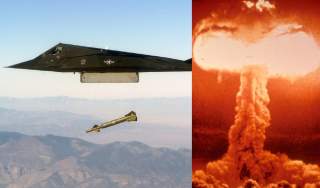The F-117 Stealth Nighthawk: A Nuclear Bomber?
No, but during the Gulf War some surely thought so.
The end result of the USAF’s Have Blue program launched in the mid-1970s, the F-117 was developed by Lockheed’s legendary Advanced Development Company. Embodying Stealth technology which made the jet virtually invisible to radar, the first of 59 production aircraft was delivered to the USAF in August 1982.
The last Nighthawk was delivered to the USAF in mid-1990, and in August of that year the 37th Tactical Fighter Wing (TFW) deployed en masse to Saudi Arabia as part of Operation Desert Shield in response to Iraq’s invasion of Kuwait. F-117s subsequently led the opening strikes of Operation Desert Storm (ODS) in January 1991.
On several missions during ODS F-117 pilots saw spectacular explosions in the distance, with some being so impressive that they resembled a nuclear mushroom cloud. There were, of course, no nuclear explosions during the war, but some targets when hit generated massive secondary detonations.
By late January 1991 the key targets in Baghdad had been eliminated and the F-117s were hunting ammunition dumps, chemical storage facilities and bunkers elsewhere in the country. Lt Col Barry E Home recalled one of these missions, which he flew in aircraft 85-0818 The Overachiever, in Warren Thompson’s book F-117 Stealth Fighter Units of Operation Desert Storm ;
`It was a two-target mission, and a confirmed ammunition bunker was my objective with my first bomb. The second one was destined for a chemical bunker. The ammunition dump was in central Iraq, 100 miles west of Baghdad. The second was just north of the Iraqi capital. I was flying at what we considered to be medium altitude, my jet being armed with GBU-27s. The ammunition dump was in a vast array of uniformly-placed bunkers in a flat, open area. Several had already been hit, but others remained intact. It was actually a double bunker configuration.
`I approached from south to north, and used only one weapon. Right after release, I detected that the thumb tracker was overly sensitive. That caused me considerable difficulty late in the delivery. At one point, the tracker caused the sight-line to move, or rather jump, approximately 100 ft south of the target. I regained control and managed to steer the weapon to final impact. The bomb hit precisely in the middle of the double bunker, striking the wall that separated them. The explosion was absolutely brilliant. It seemed to engulf the sky all around me. For a moment I was afraid that it might even reach up and grab me.’
Lt Col Home continued to his second target, where he scored another direct hit. He encountered no further problems with his tracker. At that point, he left the area and headed back to the border. Looking to the west, he saw a bright orange glow coming from the direction of his first target — 20 minutes after the initial explosion, the fire had hardly subsided.
When Home returned to base, Intelligence personnel and wing munitions experts viewed his tapes and stated that it was the largest explosion they had ever seen. It was estimated that the double bunker had contained more than a million pounds of explosives. Several F-117 pilots working in that area later reported seeing the fireworks, and being mystified about the cause. As Home flew no further sorties in that area, he did not get to see the crater he assumed his attack had created.
This first appeared in Aviation Geek Club here.

